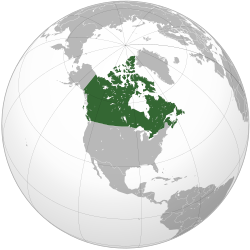This article needs to be updated.(July 2023) |



This is a bibliography of works on Canada.
For an annotated bibliography and evaluation of major books, see also Canada: A Reader's Guide, (2nd ed., 2000) by J.André Senécal, online.
Contents
- Overviews
- Geography and environment
- Atlases
- Cities and suburbs
- Climate
- Environmentalism
- Fauna and flora
- History
- Military and conflicts
- Indigenous
- Affairs of state
- Government
- Politics
- Monarchy
- Law
- Economy
- Social welfare
- Foreign relations
- Demographic and social history
- Languages
- Religion
- Immigration
- Women
- Culture
- Art
- Film
- Literature
- Media
- Multiculturalism
- Music
- Sports
- Provinces and territories
- Canadian style guides
- See also
- Internal Wikipedia resources
- Further reading
- External links
- General Reference
- Government 2
- Media 2
- Library
- Entertainment
- Statistics Canada